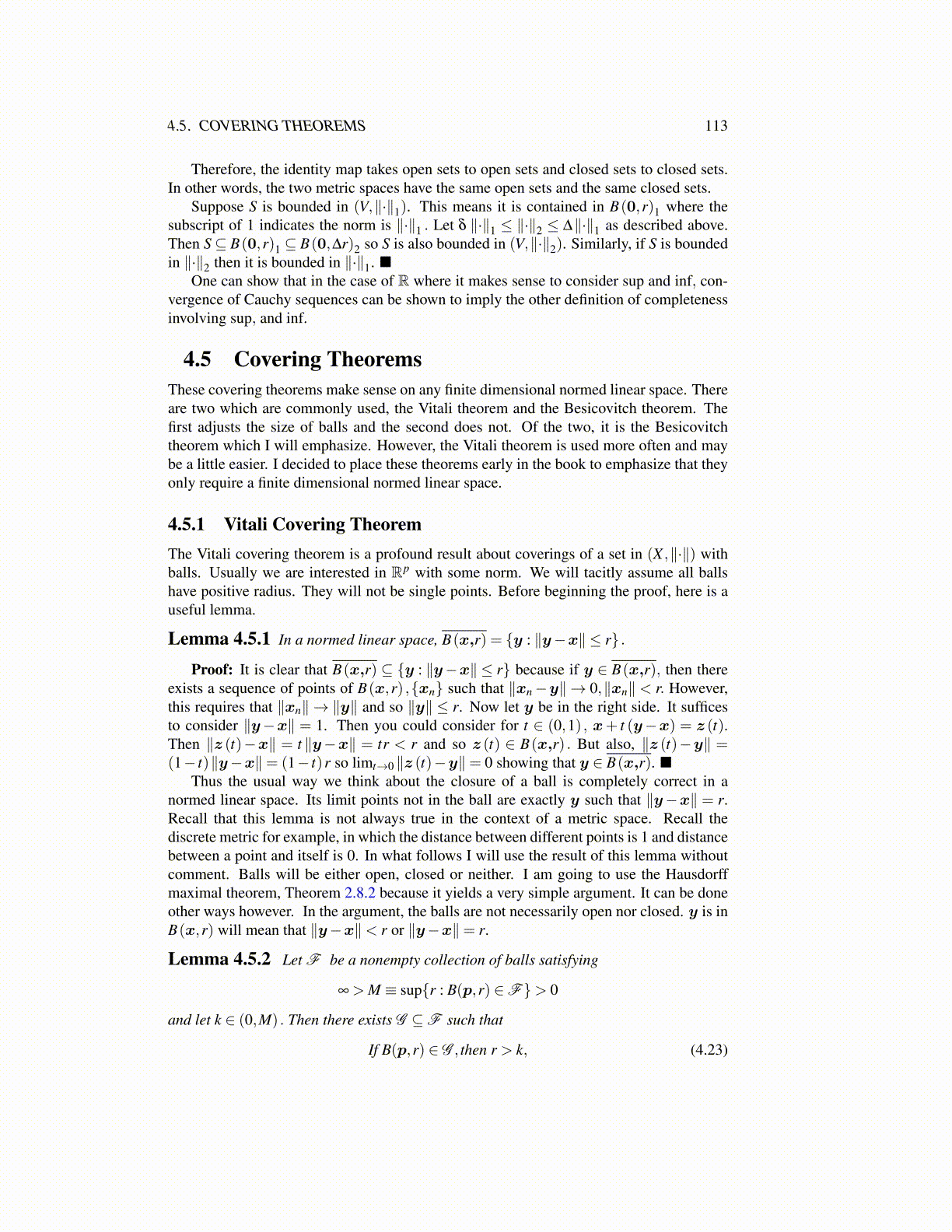
4.5. COVERING THEOREMS 113
Therefore, the identity map takes open sets to open sets and closed sets to closed sets.In other words, the two metric spaces have the same open sets and the same closed sets.
Suppose S is bounded in (V,∥·∥1). This means it is contained in B(0,r)1 where thesubscript of 1 indicates the norm is ∥·∥1 . Let δ ∥·∥1 ≤ ∥·∥2 ≤ ∆∥·∥1 as described above.Then S⊆ B(0,r)1 ⊆ B(0,∆r)2 so S is also bounded in (V,∥·∥2). Similarly, if S is boundedin ∥·∥2 then it is bounded in ∥·∥1. ■
One can show that in the case of R where it makes sense to consider sup and inf, con-vergence of Cauchy sequences can be shown to imply the other definition of completenessinvolving sup, and inf.
4.5 Covering TheoremsThese covering theorems make sense on any finite dimensional normed linear space. Thereare two which are commonly used, the Vitali theorem and the Besicovitch theorem. Thefirst adjusts the size of balls and the second does not. Of the two, it is the Besicovitchtheorem which I will emphasize. However, the Vitali theorem is used more often and maybe a little easier. I decided to place these theorems early in the book to emphasize that theyonly require a finite dimensional normed linear space.
4.5.1 Vitali Covering TheoremThe Vitali covering theorem is a profound result about coverings of a set in (X ,∥·∥) withballs. Usually we are interested in Rp with some norm. We will tacitly assume all ballshave positive radius. They will not be single points. Before beginning the proof, here is auseful lemma.
Lemma 4.5.1 In a normed linear space, B(x,r) = {y : ∥y−x∥ ≤ r} .
Proof: It is clear that B(x,r) ⊆ {y : ∥y−x∥ ≤ r} because if y ∈ B(x,r), then thereexists a sequence of points of B(x,r) ,{xn} such that ∥xn−y∥ → 0,∥xn∥ < r. However,this requires that ∥xn∥ → ∥y∥ and so ∥y∥ ≤ r. Now let y be in the right side. It sufficesto consider ∥y−x∥ = 1. Then you could consider for t ∈ (0,1) , x+ t (y−x) = z (t).Then ∥z (t)−x∥ = t ∥y−x∥ = tr < r and so z (t) ∈ B(x,r) . But also, ∥z (t)−y∥ =(1− t)∥y−x∥= (1− t)r so limt→0 ∥z (t)−y∥= 0 showing that y ∈ B(x,r). ■
Thus the usual way we think about the closure of a ball is completely correct in anormed linear space. Its limit points not in the ball are exactly y such that ∥y−x∥ = r.Recall that this lemma is not always true in the context of a metric space. Recall thediscrete metric for example, in which the distance between different points is 1 and distancebetween a point and itself is 0. In what follows I will use the result of this lemma withoutcomment. Balls will be either open, closed or neither. I am going to use the Hausdorffmaximal theorem, Theorem 2.8.2 because it yields a very simple argument. It can be doneother ways however. In the argument, the balls are not necessarily open nor closed. y is inB(x,r) will mean that ∥y−x∥< r or ∥y−x∥= r.
Lemma 4.5.2 Let F be a nonempty collection of balls satisfying
∞ > M ≡ sup{r : B(p,r) ∈F}> 0
and let k ∈ (0,M) . Then there exists G ⊆F such that
If B(p,r) ∈ G , then r > k, (4.23)